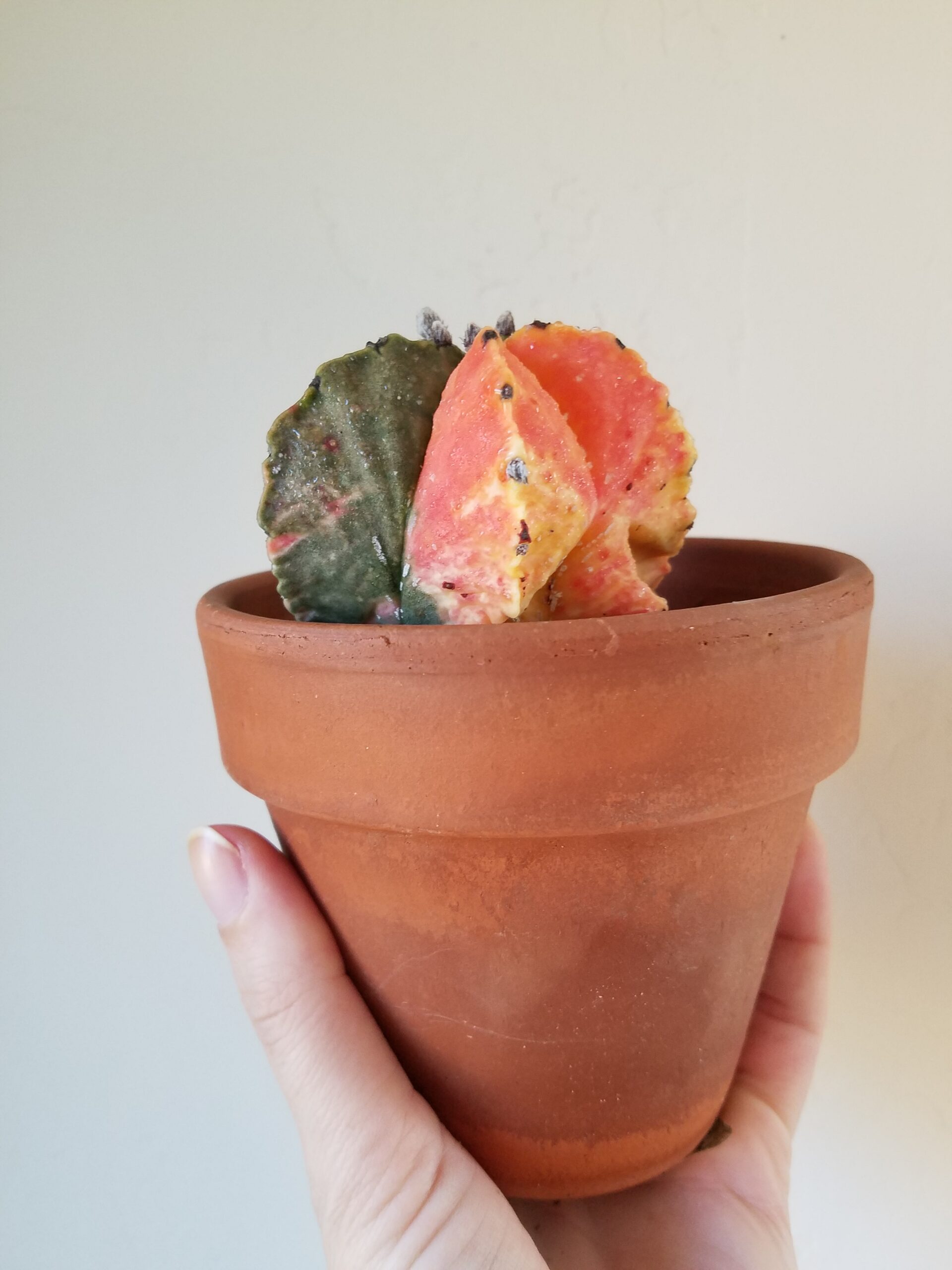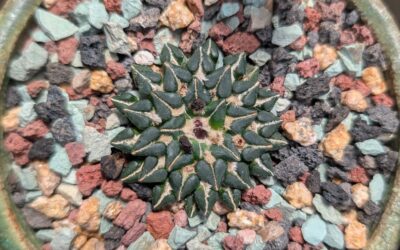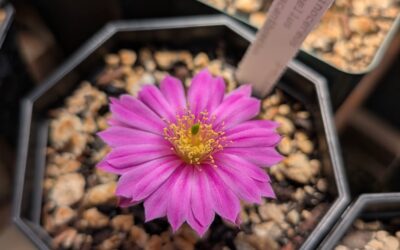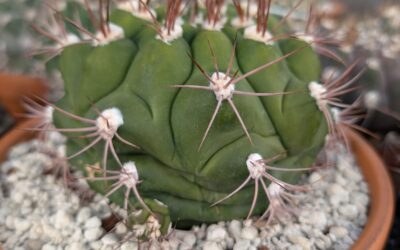Astrophytum Myriostigma – Variegated
Various forms of Astrophytum were some of the first true “collector” cacti I ever purchased. Being a complete novice at the time, I ordered my first specimens from China, not realizing they’d be recently degrafted and need time and care to root. At that point in time, ordering cacti from overseas was honestly super cheap, and even though they arrived with no roots, I figured at least my mistake would be cheap.
Now that I’ve had my plants for some time, I greatly prefer to purchase locally or at least from sellers who are shipping rooted specimens. If you’re new to collecting cacti in general, you’ll want to look for plants that are established, rooted, and at least “shipped bare root” or with the root ball intact. Degrafts are tough, and I rarely if ever import from overseas sellers anymore due to the challenges of rooting the recently degrafted plants. At this point, I’ve lost about half the plants I’ve ever tried establishing, although that is likely due to my own haphazard setup for the plants than anything else. Don’t be me and be lazy about your degraft setups if you want them to succeed! Better yet, support local sellers and buy locally or from small shops.
I care for my variegated Astrophytum myriostigma with a little extra love and attention than my normal plants. It’s in partial shade to prevent burning, and is watered regularly although sparingly through the summer. It gets a little extra fertilizer as well; I add some of the diluted fish emulsion I use for my tropical plants to this guy once or twice a year in summer as a little extra boost. This year is the first year I’ve tried a cactus/succulent-specific fertilizer, and we’ll see if that has any appreciable impact.
Picture Journey Time
I have several myriostigmas, acquired from a few different sources and growing in different conditions.
My first, and the focus of this post, was my variegated nudum, purchased through eBay from a seller that no longer seems to be in business. It arrived with only a bare root nub, and I had to figure out, quickly, how to root it when I had never done so before.
This is a terrible idea that I do not recommend.
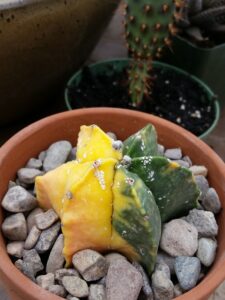
This little astrophytum wasn’t originally labelled as a “nudum”, but as it’s grown, it’s pretty much shown those traits. The photo above is the day I unpacked it in June 2016. I didn’t know it at the time, but the nearly half green portion is probably the only reason I was able to get this rooted and growing – the yellow portion of the variegated plants is completely lacking in chlorphyll. With a little bit of critical thinking, you can gather that without chlorophyll, there is no energy produced for the plant. With just less than half of this cactus having green on it at all, it is much slower growing than the fully green or normal colored cousins.
After a while, it became established, rooting itself and even producing a flower about a year later! The photo below is from July of 2017. If you compare the below photo to the one above, it has grown somewhat and the appearance of six ribs has faded to look like the distinct 5 ribs that is normal for the species.
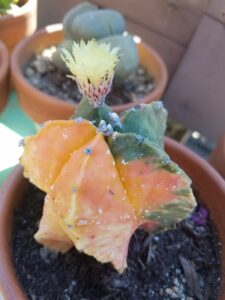
Only the blooms on the green portion ever reached a point of “proper” blooming; blooms since this rarely reach full size or open. The plant looks larger in the next photo, but that’s only because it doesn’t have nearly as many rocks for top dressing due to the variegated side getting some rot in it over the winter of 2016. Again, compared to the normal colored astrophytum myriostigma, this is not nearly as robust and has been very prone to various issues. One of the worst has been chronic issues with rust; something that has hit a few of my plants pretty hard for a couple winters in a row.
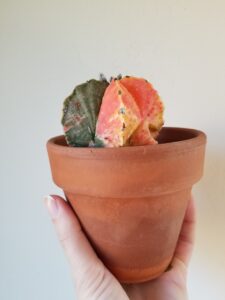
Above is the little variegated astro in November of 2017, right before the wettest winter months hit. It’s still small, and fits comfortably in a 4″ pot, which is about the size of terra cotta pot I had it in to begin with. The soil mix was also not ideal; I didn’t figure out an ideal blend of organic and inorganic materials for a few years. All things considered, it’s a bit of a miracle it’s survived!
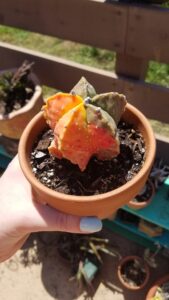
Most of the photos I have show the plant from its best angle, trying to hide some pretty significant scarring it developed from the rust that attacked it. The photo above is from April of 2018, and it had been hit by some rust that past winter. It also recovered from the rot that took out a small chunk under the base, and if you use that little sixth rib as a gauge for growth/size, you can see that while it’s still small, it’s definitely growing.
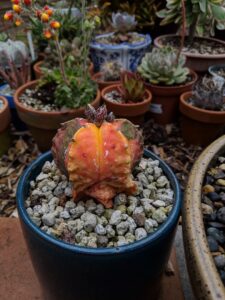
The photo above is almost exactly a full year later – I repotted it into a larger pot, added more inorganic mix to it, and hoped that the refreshed soil and extra space would help it grow more and faster. Spoiler: it did not.
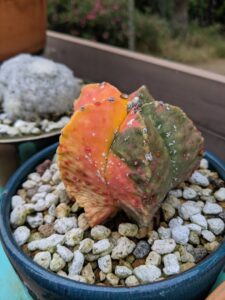
This is two months later; I took this picture because I thought I was seeing new growth between the ribs. I was not. It was still too cold and wet for the usual growing period for astrophytums. June in our area is typically a gloomy, muggy time, with the phrase “June Gloom” being quite literal. Lots of clouds, temperatures in the 70s, and occasional rain.
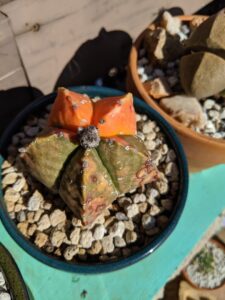
August of 2019 (the beginning of embracing the scars on the green side, which were strategically hidden by angles in previous photos. My readers, embrace that your cacti won’t always be picture perfect. The scars are character, and is not a reflection of you being a poor grower nor are they anything to be embarassed about. Interestingly, if you compare this photo to the original photo, the sixth rib has shifted down far enough that you can’t see it from the top, and with age, the cactus has developed more green over the ribs than the original variegation. This photo has some sunset coloration to it, but after a summer of nearly full afternoon sun, the cactus also went from yellow variegation to orange.
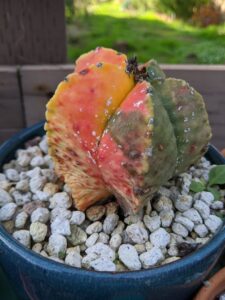
Showing the cactus from a side angle; it was developing a distinct gangster lean by January of 2020. I suspect the lean is from the rust scars/stunted growth on the green side after another wet winter.
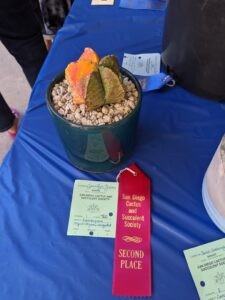
Scarred or not, I entered this cactus in the San Diego Cactus and Succulent Society Show in February of 2020, right before COVID-19 had really hit the US and about a month before lockdowns stopped any gatherings like this. Second place isn’t bad, until you learn that there were only two entries in the category. Whomp whomp.
The judges commentary while judging the entries were generally that my cactus had too much scarring, and they would like to see it “cleaned up” – this isn’t really possible for the types of scars my cactus has. It will simply have grow large enough that the scarred portions are no longer so prominent.
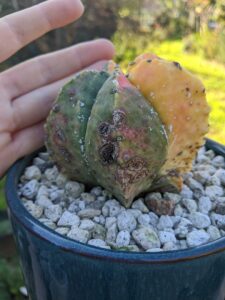
Here are the scars in March of 2020, showing the rough damage from rust. It will take quite some time to grow out, but the cactus has been thriving lately. I repotted it this summer into a smaller pot with better draining soil, and have made sure to keep watering sparse. After seeing how well the in-ground plants have done with lots of heat and minimal water, applying the same pattern to the potted cacti has done wonders. You’ll probably recognize the next photo, as this cactus is featured all over my site!
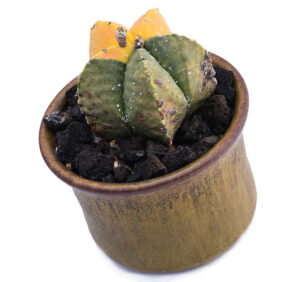
That’s the cactus as of August, 2020, and if you look closely you can see that the scarred portion is already fruther down on the spine than it was in the March photo. I’m optimistic that with time, the scars will be difficult if not impossible to see on the plant with age.
Thank you for reading, and I look forward to sharing more updates with you in the years to come!

